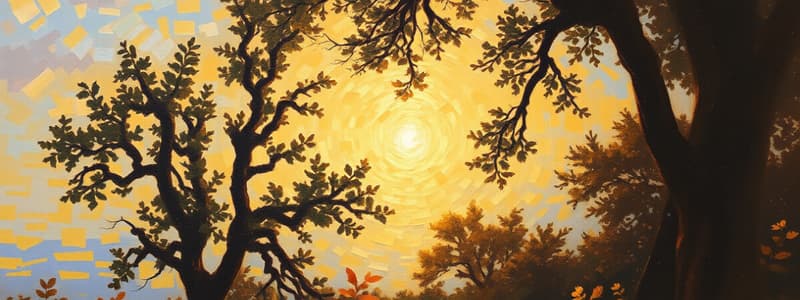Podcast
Questions and Answers
What criticism is made about common definitions of art?
What criticism is made about common definitions of art?
- They are often too technical and exclude creativity.
- They fail to account for different cultural perspectives.
- They suggest only humans can create art. (correct)
- They are frequently too vague and lack meaning. (correct)
Which statement best reflects James Baldwin's perspective on the purpose of art?
Which statement best reflects James Baldwin's perspective on the purpose of art?
- The purpose of art is to create beautiful objects.
- Art should provide clear answers to questions.
- Art serves no real purpose in society.
- Art is meant to challenge concealed questions. (correct)
What is implied about the definition provided by Oxford regarding art?
What is implied about the definition provided by Oxford regarding art?
- It takes into account non-visual forms of art.
- It accurately represents the essence of art.
- It may restrict the viewer's experience of art. (correct)
- It encompasses all historical definitions of art.
What is the viewpoint of ancient philosophers like Seneca regarding art?
What is the viewpoint of ancient philosophers like Seneca regarding art?
What does the speaker hope to achieve by gathering quotes about art from various writers and artists?
What does the speaker hope to achieve by gathering quotes about art from various writers and artists?
What does Bertold Brecht suggest about the role of art in relation to reality?
What does Bertold Brecht suggest about the role of art in relation to reality?
According to Chinua Achebe, what is a fundamental characteristic of art?
According to Chinua Achebe, what is a fundamental characteristic of art?
What does the phrase 'Art is long, life is short' primarily convey?
What does the phrase 'Art is long, life is short' primarily convey?
What aspect of art does John Dewey highlight in his writings?
What aspect of art does John Dewey highlight in his writings?
According to Thomas Merton, what dual function does art serve?
According to Thomas Merton, what dual function does art serve?
Flashcards are hidden until you start studying
Study Notes
Definition of Art
- Abrose Bierce noted that art has no definitive explanation, reflecting the complexity of its meaning.
- Oxford defines art as the expression of human creative skill but overlooks the capabilities of other animals.
- Personal interpretations suggest art can be appreciated for reasons beyond beauty or emotional power.
Philosophical Perspectives
- Ancient philosophers like Seneca and Aristotle sought to define art, with varying degrees of inclusivity.
- Seneca viewed art as imitation of nature, a restrictive perspective that doesn't encompass contemporary works.
- Aristotle posited that art completes what nature cannot, suggesting an extension of reality through creative processes.
Art as Experience and Perspective
- James Baldwin emphasized that art reveals concealed questions, allowing for diverse interpretations.
- Paul Klee and Bertold Brecht framed art as an active force to shape reality, not merely reflect it.
- Chinua Achebe described art as humanity's effort to create alternate realities from the given world.
Art as Communication
- John Dewey called art the most effective mode of communication, emphasizing its experiential nature.
- James Turrell described art as a "completed pass," necessitating viewer interaction for full realization of its meaning.
- Thomas Merton and Louise Bourgeois highlighted art's role in self-discovery and modern relevance.
Temporal Nature of Art
- "Art is long, life is short" reflects the enduring nature of artistic works compared to their creators.
- Kerry James Marshall explained that art should hold significance independent of the artist’s identity.
Emotional Dimensions of Art
- Art serves as sustenance for both creators and audiences, providing relief from life’s pressures.
- Dorothy Parker described art as catharsis, highlighting its role in expressing emotions.
- Edvard Munch noted art is born from human experiences, primarily through grief.
Conceptual and Experimental Dimensions
- Ralph Waldo Emerson suggested all conscious acts of expression qualify as art, broadening its definition.
- Conceptual artists like Sol LeWitt asserted that ideas alone can constitute art without physical manifestation.
- Artistic creation often entails risk, as explained by Francis Ford Coppola, allowing for unprecedented beauty.
Art and Truth
- Various thinkers likened art to magic and deception, as it can concurrently convey truths and challenge perceptions.
- Art has historically been manipulated by powers but also serves individual expression and collective experiences.
Changing Nature of Art
- Elbert Hubbard characterized art as a way of being rather than a defined object.
- Duchamp noted that art exists in the gaps, emphasizing the interaction between art and audience perception.
Openness of Art's Definition
- The notion that art should evolve allows for ongoing exploration and inclusion of diverse perspectives.
- This fluidity challenges the notion of a single, lifetime definition, embracing all interpretations and innovations within art.
Conclusion
- Various perspectives amalgamate to create a rich understanding of art, underscoring its uniqueness and habitual appeal.
Studying That Suits You
Use AI to generate personalized quizzes and flashcards to suit your learning preferences.




